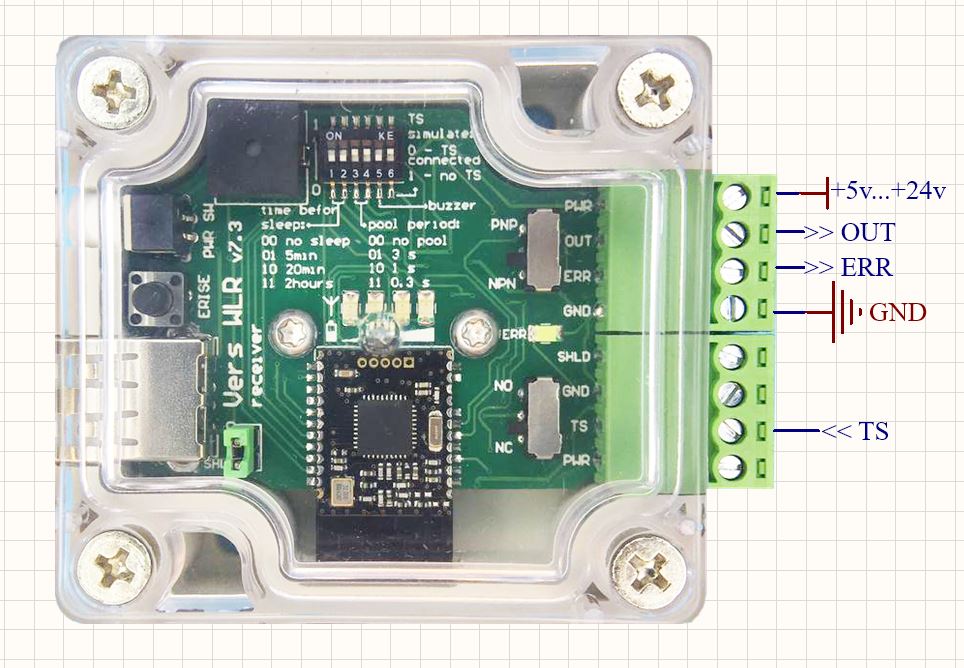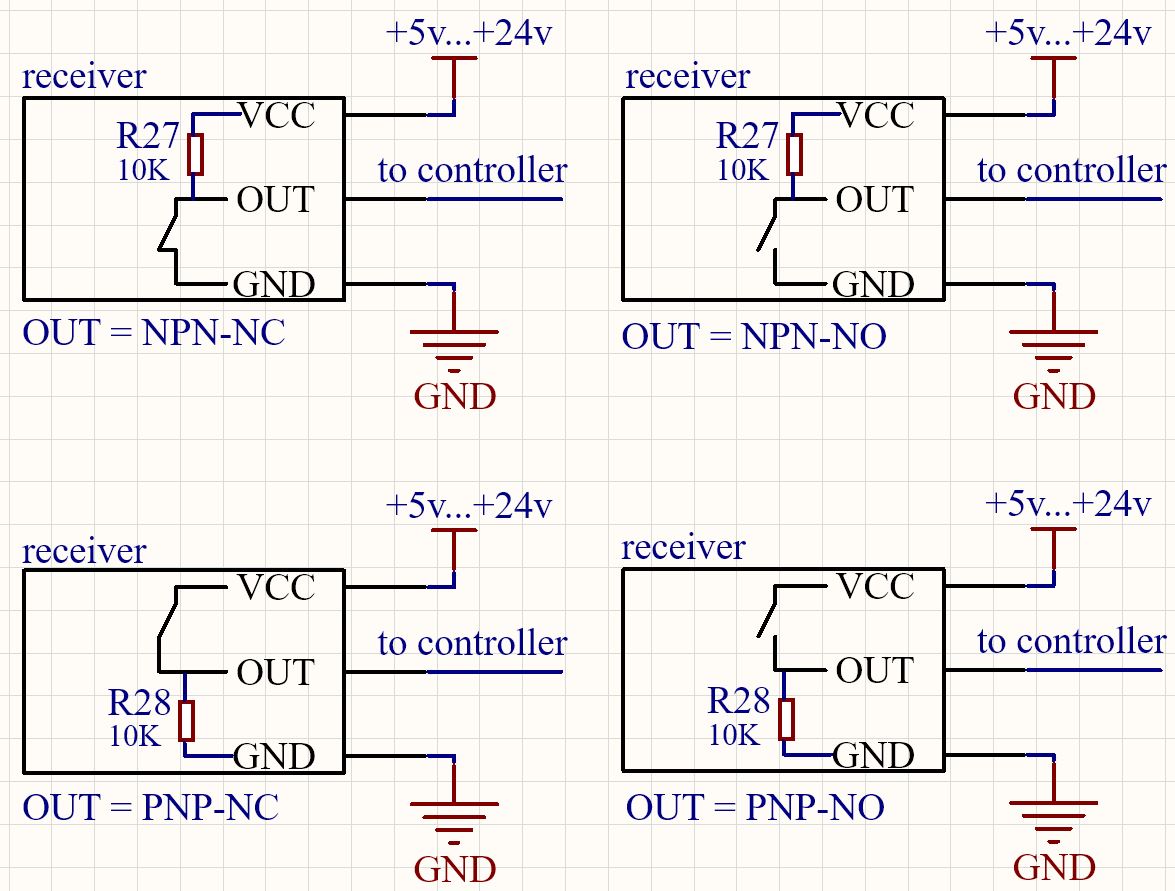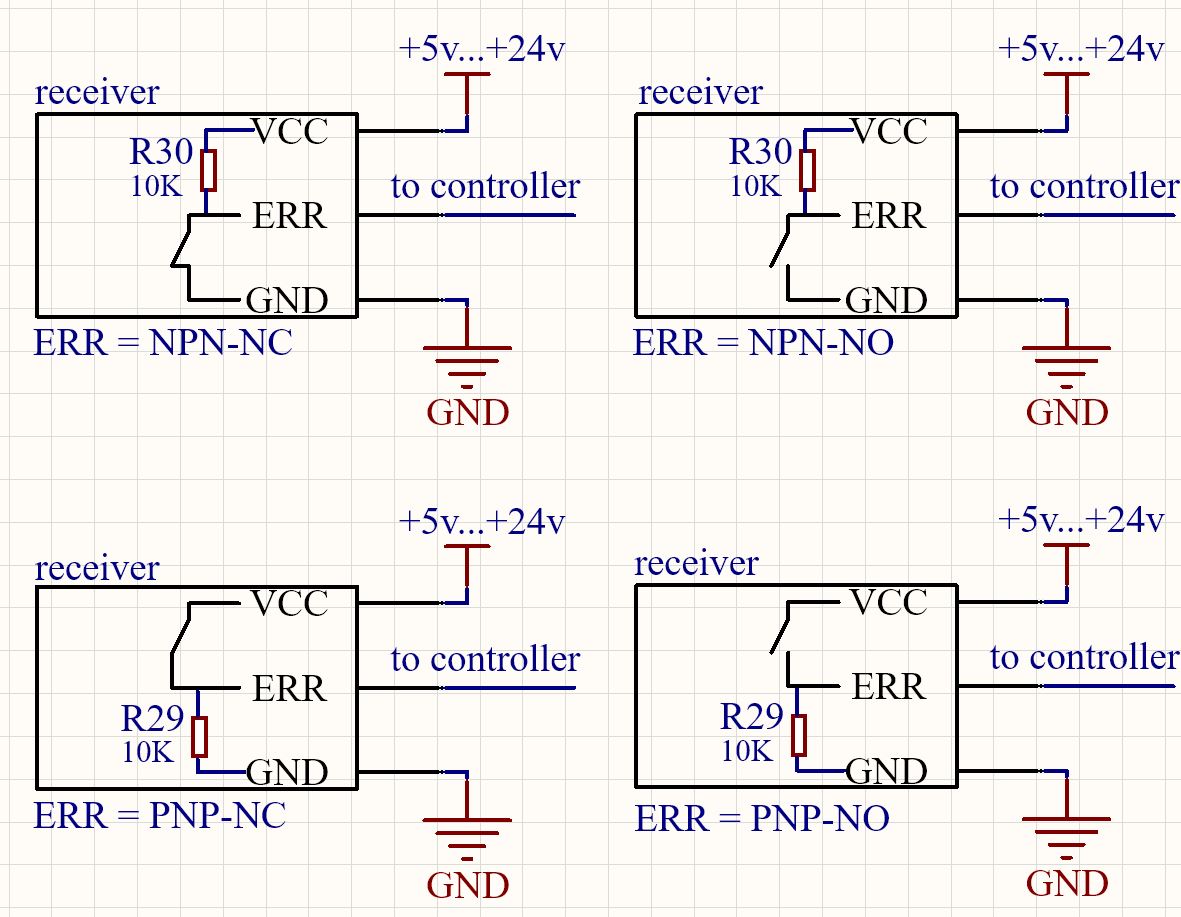This "User's Guide" refers to the Vers WTSm v7 model currently in production. For models VersWTSm v2 and below the "User's Guide" is located on this link.
Purpose.
The Vers WTSm sensor is used to determine tool height and diameter. CNC milling machine generates coordinates when the tool touchs the Vers WTSR measurement platform and uses them to calculate the height and diameter of the tool. The device can be used with various CNC systems: LinuxCNC, Mach3, embedded systems on industrial machines, etc. The device communicates by air at a frequency of 2.4 GHz with a receiver and then by wire with a CNC system. The transmitter is built into the tool setter. The receiver is supplied as a separate pcb.
Specifications.
Unidirectional repeatability | < 0.002 mm |
Search directions | ±X, ±Y, -Z |
Permitted deviation of the measuring pad in XY directions | ±5mm |
Permitted deviation of the measuring pad in Z direction | - 4mm |
Contact force | min 0.5N max 2N |
Diameter and overall height | D=32.4mm, H=47mm |
Diameter* and height of the ceramic pad | D=10mm, h=2.5mm |
Delay in the radio channel | ~ 1.5 ms |
Power supply of sensor (transmitter) | LIR2477 3.6v |
The possibility of charging | Yes |
Current сonsumption of sensor (transmitter) | <0,6mA |
Power supply of receiver | +5v...+24v |
Current сonsumption of receiver (for different Vin) | 21 mA (5v) 14 mA (9v) 12 mA (12v) 8 mA (24v) |
Radius of the radio channel | 6 m |
Radio frequency | 2,4 GHz |
Dust protection | Yes |
Splash protection | Yes |
Adjustability | Yes |
Possibility to measure tool diameter | Yes |
*Diameter 9.98 ±0.02mm, cylindrical and planar irregularity <2µm
Features:
- the ability to connect the receiver to power sources in a wide range of +5V ... +24V at the input and at the output,
- the ability to select different schemes of connection to the CNC controller: NPN-PNP, NC-NO,
- hardware implemented ability to integrate with npn-nc toolsetter on one common output and work independently,
- automatic selection of the most unloaded frequency sub-band 2.4 GHz,
- the ability to set sleep modes,
- the ability to correct signal delays thanks to a separately outputted error signal.
- ultra-low current consumption by the probe, 0.6 ma when realizing continuous radio communication, 0.06 ma in sleep mode, 0 ma when the power button is off,
- power supply of the sensor from the LIR2477 3.6v battery with possibility of charging, applied increasing the voltage on the contact group up to + 16v for sure closing of contacts,
- the frequency of recharging with daily use is on average 1-2 times a month, the charging time is 2 hours. You can continue to use the sensor when charging from the receiver, charging is also possible from any 5 volt chargers and from the computer USB port.
- when a cable is connected to receiver for charging, the sensor begins to transmit a trip signal on this cable, which can be useful in some cases (for example, with powerful radio interference),
- LED and buzzer indication of stylus pressing, radio signal level, battery charge level, error signal.
About radio channel:
- the delay in the radio channel is 0.75 milliseconds, in the entire chain from the ball contacts of the sensor to the output signal of the receiver is 1.5 milliseconds,
- provides a normally-closed connection of the probe to the receiver (continuous radio communication),
- the reliability of a normally closed loop via a radio channel is provided by a protocol with acknowledgment of reception and duplication of unconfirmed data,
- the delay of the programmed (for triple absence of acknowledgment) response of the receiver to the break of communication over the radio channel is less than 0.3 s, which provides a safe search at speed up to 1000 mm/min,
- ultra low consumption, power supply of the transceiver from one LIR2477 3.6 volt battery, current consumption in the wake-up mode of the probe (averaged) 0.6mA,
- Sleep mode 1. When the probe is not in use, automatic transition to Sleep mode after a user-selected time interval (switch "Time to sleep" on the receiver, see below). Shaking or rotating in the spindle from 200 rpm wakes up the probe. Another way to enter Sleep Mode 1 is to hold pressed the stylus for 10 seconds. Current consumption in Sleep mode 1 - 0.06 mA. Sleep mode 2. When the receiver is turned off (for example, together with turning off the machine), the probe automatically switches to Sleep mode 2. A short automatic wakeup to search for a newly connected receiver will occur every 15 seconds. If before turning off the receiver the probe was already in Sleep mode 1, then it will remain in it. Current consumption in Sleep mode 2 - 0.07 mA. Before turning off the receiver, make sure that the stylus is not pressed (the red LEDs on the probe is not lit), the probe will not go to sleep when the stylus is pressed.
Installation.
![]() Placement Vesr WTSm is recommended to be chosen so that the entire surface of the ceramic platform of the device is in the working area of the machine, with an indent from the boundaries = the maximum diameter of the tool being measured + 2mm.
Placement Vesr WTSm is recommended to be chosen so that the entire surface of the ceramic platform of the device is in the working area of the machine, with an indent from the boundaries = the maximum diameter of the tool being measured + 2mm.
The device is fixed to the machine body with three M3 screws. Three threaded holes are prefabricated in the machine body:
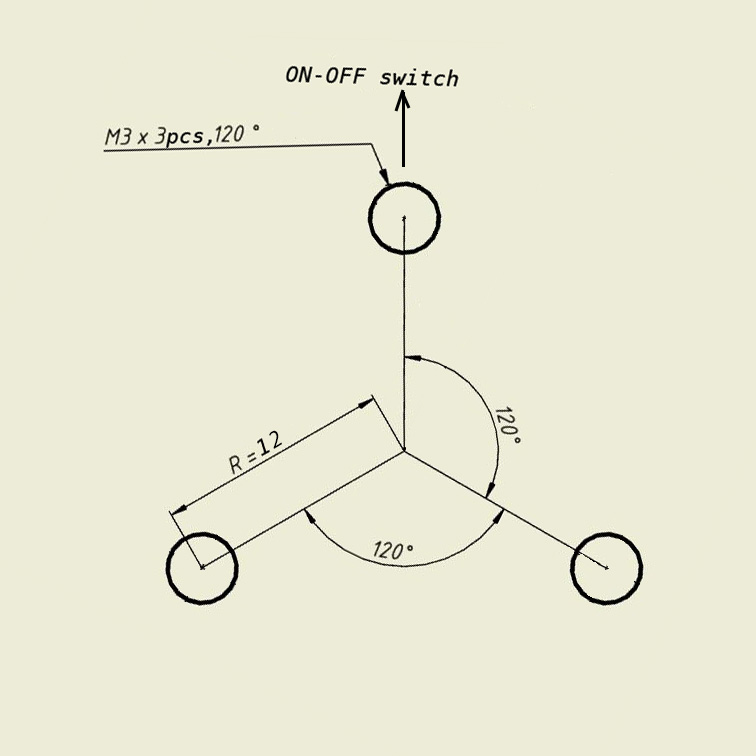
Connection
![]() The Vers WTSm consists of 2 parts: a touch probe and a receiver. To start, you first need to turn on the receiver, then the probe.
The Vers WTSm consists of 2 parts: a touch probe and a receiver. To start, you first need to turn on the receiver, then the probe.
![]() To charge the battery, turn OFF the probe and receiver, connect them with the supplied USB cable, turn ON the probe, than receiver. Also , instead of the receiver, you can use any 5 volt DC source with a USB port for charging, as well as a computer USB port.
To charge the battery, turn OFF the probe and receiver, connect them with the supplied USB cable, turn ON the probe, than receiver. Also , instead of the receiver, you can use any 5 volt DC source with a USB port for charging, as well as a computer USB port.
![]() To transmit the probe trigger signal via USB cable, turn OFF the probe and receiver, connect them with the supplied USB cable, turn ON receiver only.
To transmit the probe trigger signal via USB cable, turn OFF the probe and receiver, connect them with the supplied USB cable, turn ON receiver only.
Functions of switches and pinout of the receiver connector.
«Time before sleep» specifies the interval of inactivity of the probe, through which the probe will automatically enter sleep mode. Exit from that sleep mode - by hold down the stylus 5 seconds. There is an important difference in the receiver's operation, depending on whether "Time to Sleep" is set or off (in the state of the switches 00). If the "Time to Sleep" is not set, turning off the probe or breaking the radio has the same effect as pressing the stylus - the output signal appears on the OUT of the receiver. If the "Time to Sleep" is set, turning off the probe, or going it into sleep, or breaking the radio does not affect the OUT output, but initiates the ERR output. This allows you to continue to use the second connected TS sensor. When "Time to Sleep" is set, it is recommended either to press the stylus for waking 5 seconds or to test the ERR signal before each measurement and 5 seconds to press the stylus only if there is an ERR signal.
Output "ERR" - The Error signal is a detector of excessive (greater than 1.7 milliseconds) delays. Accompanied by LED indication in the receiver. Provides the ability to cancel an incorrect measurement in the event of a delay in the response of the radio channel. The delay occurs when a short acknowledgment packet was still sent at the moment the stylus was pressed, the delay can be up to 12ms. The probability of such an event, depending on the period of acknowledgment packets specified by the user ( pool period ): 0.3s - 3.6%, 1s -1.2%, 3s - 0.4%. The software check of the Error signal is set immediately after the search for G38 (linuxcnc), G31(mach3), before releasing the stylus, if an Error signal is detected, it is recommended to perform the measurement again. Alternatively, you can not use ERR, then, to be completely sure of the measurement, measure one place twice and accept if both measurements coincide with the required accuracy. Also, if you make a latch measurement at a speed of <10mm/min, the error from the maximum possible delay will be <0.002mm, in some cases this may be sufficient. Also, ERR is used to determine the need to wake up the probe from Sleep mode 1. Then to wake up: in manual mode - shaking, in automatic mode - software check of the Error signal is performed before searching G38 (linuxcnc), G31(mach3), in case of detection of the Error signal ERR it is necessary to rotate probe in the spindle 200 - 1500 rpm.
To work with the Err signal, it is necessary that your cnc controller has 1 free input pin. ERR out should be considered as a separate sensor that connects to this input pin.
For LinuxCNC users:
The Optional Interpreter feature needs to be turned-on. http://linuxcnc.org/docs/2.7/html/remap/remap.html#_optional_interpreter_features_ini_file_configuration
[RS274NGC]
FEATURES = 30
In the configuration .hal file, this input is assigned a digital pin:
net signal-name motion.digital-in-00 <= parport.0.pin10-in
The state of the digital input is read in the right place of the g-code program using the command M66, http://linuxcnc.org/docs/html/gcode/m-code.html#mcode:m66
M66 P0 L0
The current value of the input is stored in parameter #5399", For check it
(DEBUG, #5399)
o100 if [#5399 EQ 1]
"Buzzer" activates the sound signal by pressing the stylus.
«NC NO» selects between a normally closed NC (recommended) and a normally open NO connection circuit for output pin.
«NPN PNP» selects between npn and pnp the connection circuit for output pin.
Switches «NC NO» and «NPN PNP» selects one of the 4 circuits of the receiver connection to controller (note, the controller may have its own supply voltage limits).
Pull-up (pull-down) resistors are already soldered at the outputs of the receiver, see the diagrams below.
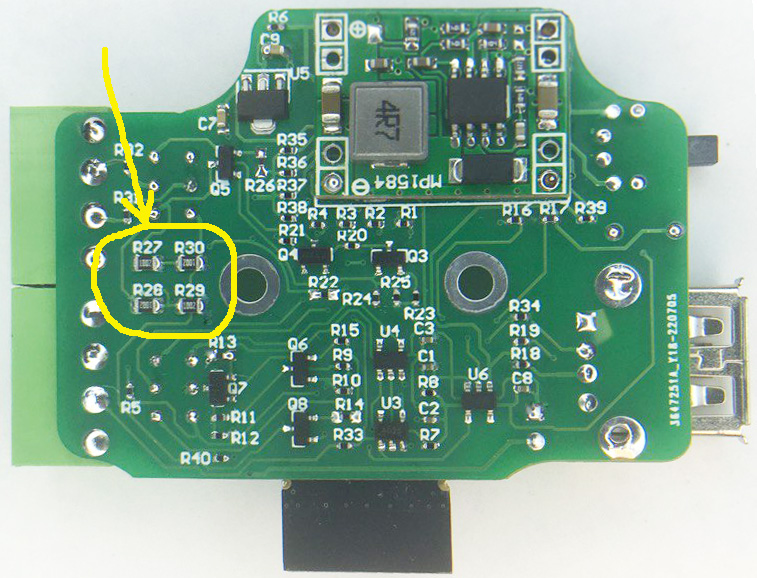
Input "TS" is used to connect the NPN-NC sensor to the VersWTSm receiver to one common "OUT" output in the OR logic, which allows any of the sensors to be switched off independently (for example, if WTSm "gone into a sleep", NPN-NC sensor will remain in working order). The NPN-NC sensor connects to the WTSm as shown in the diagram below and in this case uses the WTSm power supply. NPN-NC sensor can also use its own power supply.
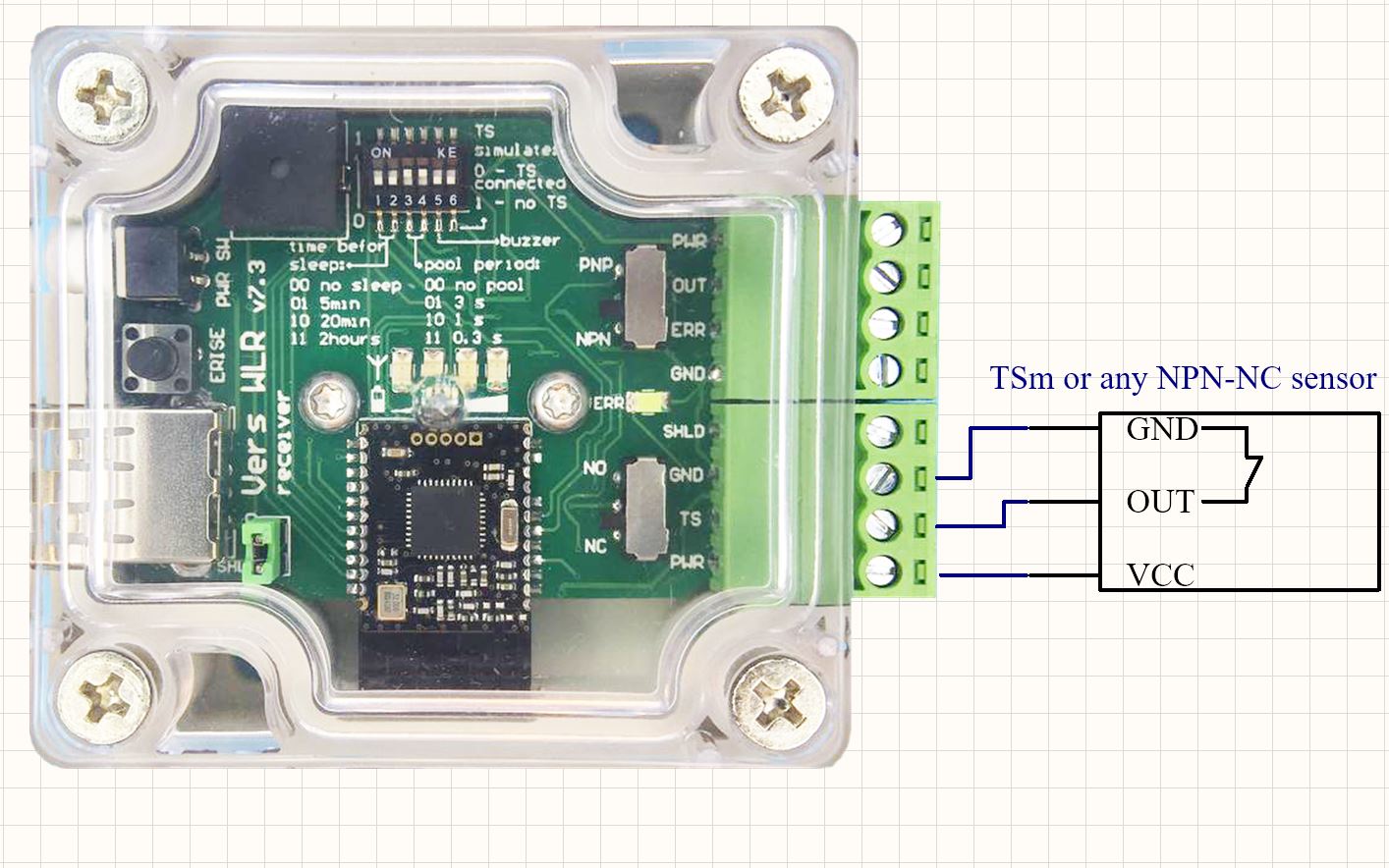
"ERISE" ("SERV") button - when the receiver is switched on and that button is pressed simultaneously, one of two service procedures is performed:
1. "Binding probe to receiver" if the probe is connected to the receiver with a USB cable.
2. "Storing TS status" if the probe is not connected to the receiver with a USB cable.
Binding probe to receiver
The devices are shipped with the binding procedure already completed. This procedure is only needed to bind the receiver and probe from different kits.
1. Turn off the receiver, probe, and all Vers wireless devices in the same room.
2. Connect the receiver and probe with a USB cable.
3. Erasing flash-memory: while holding down the "ERISE" button, turn on ONLY the receiver, while the probe must be OFF, release the "erase" button, 4 short beeps will notify you of the successful erasing of the memory. Turn off the receiver. Disconnect the USB cable. The memory was cleared both in the receiver and in the probe.
4. Writing information about the new partner to the flash memory: turn on the receiver, 5 short beeps will notify that the memory has been erased. Turn on the probe. The receiver and the probe communicate wirelessly, automatically exchange and store information about the partner in flash memory when you first turn it on.
Storing TS status
The devices are shipped with the procedure already completed, the status "no TS" is saved in the flash memory, i.e. there must be no connection at the "TS" input of the receiver. Another possible status is "TS connected", ie. a NPN-NC sensor is connected to the "TS" receiver input.
This procedure needs to be performed once when NPN-NC sensor physically connects to (or disconnects from) receiver.
1. Turn off the receiver, disconnect the USB cable from the receiver, nothing should be connected to the "TS" input, even if the "TS connected" status is needed there.
2. Set DIP switch #6 "TS simulate" to desired position: i.e. 1 (ON) - "no TS", the NPN-NC sensor will not be physically connected, it will be simulated; 0 (OFF) - "TS connected", the NPN-NC sensor will be physically connected.
3. With the "ERISE" button pressed, turn on the receiver, 2 short beeps will notify that the "no TS" status has been stored in the memory, 3 short beeps - the "TS connected" status has been stored in the memory. Turn off the receiver.
4. If the status "TS connected" has been selected, the NPN-NC sensor must be physically connected.
Probe LED indication
- red LED is ON: stylus pressed;
- green LED 1 short ON pulse: stylus released;
- the green LED is constantly lit or switches 2 times per second: the link with the receiver is broken, it is necessary to restart (off-on) the receiver, and then the probe.
- the blue LED is on: the battery is charging, with a strong battery discharge the blue LED may not turn on immediately while the dynamic control system restores the charge to a safe minimum level.
Receiver LED indication
- combination of active red LEDs immediately after turning on the receiver: the number of the clearest subband;
- red LEDs are ON: stylus pressed, active LED quantity corresponds to level of transmitted radio signal;
- green LEDs are ON: stylus released, active LED quantity corresponds to the battery charge level;
- blue LED ON: radio link error, ERR output status indication.
Adjustment.
Before starting the measurement, it is necessary to adjust the device. As a result of the adjustment, the surface of the measuring platform should become parallel to the XY plane.
![]() The indicator should be sensitive to a weak effect of 0.3-0.5N (for example, most lever indicators have this property).
The indicator should be sensitive to a weak effect of 0.3-0.5N (for example, most lever indicators have this property).
For adjustment, three points are selected at the measuring pad (shown with red crosses) approximately at the edge of the site in the direction of the adjustment holes. The indicator is set in the spindle (you will need to moving the spindle in XY coordinates), the stylus of the indicator is located to measure the deviations in height. The results of the indicator must have to the same values in these three selected points. For adjustment, a 2mm hex key is used from the kit, both screwing in and loosening of the adjustment screws located inside the holes, closed with elastic bands. The key is recommended to hold for a short lever, so as not to develop excessive force when screwing.
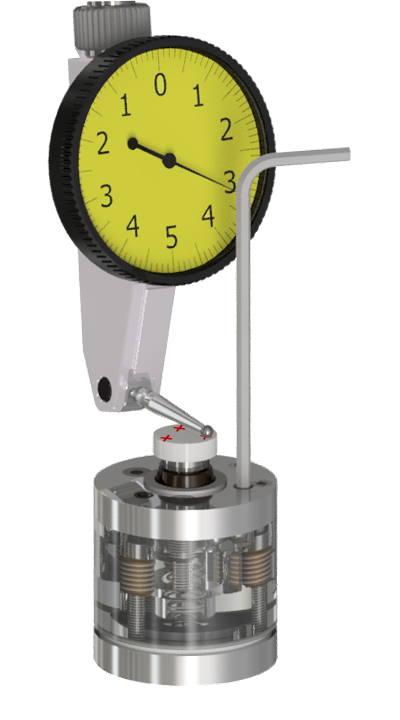
Using.
There is software ProbeScreen and Auto Tool Measurement in free access for convenient work with probe in the LinuxCNC(ver.2.6 and higher),
Probe Wizard - in the Mach3 system.


